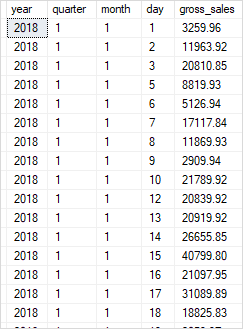

The date and time for an event are the most commonly recorded data that is stored by many applications in various organisations. DAY, MONTH, SECOND ) or a string literal ( 'day', 'month', 'second. Redshift Datepart Function: Syntax and Examples. Both functions are useful for formatting data and ensuring consistency in your results. LPAD allows you to pad a string with a specified character on the left, while RPAD does the same on the right. SELECT CURRENTDATE, (CURRENTDATE - INTERVAL '3 months')::date. Be careful Redshift works in UTC, so the CURRENTDATE might suffer from timezone effects and be +/- what you expect sometimes. declare dt datetime set dt GETDATE () select WhichWeekOfMonth datepart (wk, dt) - datepart (wk,dateadd (m, DATEDIFF (M, 0, dt), 0)) + 1, case when (datepart (wk, dt. There is a 2nd column that uses a CASE statement over the expression, to show either 'Odd' or 'Even'. A curious difference between the two functions is that DATEDIFF will accept either a raw interval for its first argument (e.g. In conclusion, the LPAD and RPAD functions in Redshift are powerful string functions for manipulating character strings in SQL queries. SELECT FROM pkgdata WHERE scandate > CURRENTDATE - INTERVAL '3 months'. This gives you the week of the date dt within its month. Left outer join dates d on extract('day' from date_trunc('day',d.calendar_date)) = extract('day' from ps.created_at) AND date_trunc('day',d.calendar_date) >= date_trunc('day',ps.created_at) AND date_trunc('day',d.calendar_date) < date_trunc('day',ps.archived_at) AWS provides documentation on DATEDIFF(), however no record of datediff() appears to exist within either Redshift or PostgreSQL documentation. selectĮxtract('day' from ps.created_at) as extract_day, You can extract part of a timestamp by applying the EXTRACT. To get the complete list of possible values, please refer to the Redshift Documentation. Because it isn't grabbing the leading zeroes. To find rows created within the last week: SELECT FROM events WHERE eventdate > dateadd (week, -1, sysdate) The dateadd () function accepts second, minute, hour, day, week, month, and year. But right now my SQL makes it look like: 443.

I used the below query which works when an ended_at timestamp is present, however, when it is null, I need to have the next month populated until an ended_at timestamp is present. CAST (DATEPART (HOUR,s.Arr) AS VARCHAR) + CAST (DATEPART (MINUTE,s.Arr) AS VARCHAR), The original s.Arr field looks like: 04:43:00.000. The goal is to associate the monthly amounts paid by a user to the dates when starting with only a start and end date. So if I had a created_at timestamp of, I would have a column with additional rows for, ,, etc. Question: How can I take a start timestamp (created_at) and end timestamp (ended_at) and add a column that adds 1 month to the start timestamp until the end timestamp. For more information, see Date parts for date or timestamp functions. Also have a dates table with all calendar dates that can be utilized. The date part (year, month, day, or hour, for example) that the function operates on.


 0 kommentar(er)
0 kommentar(er)
